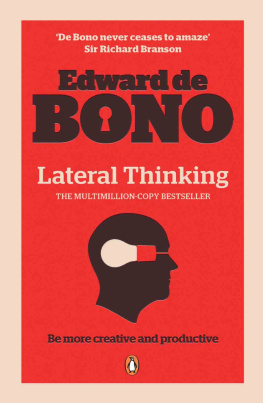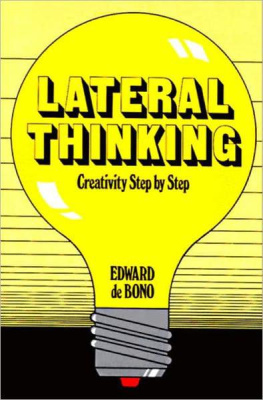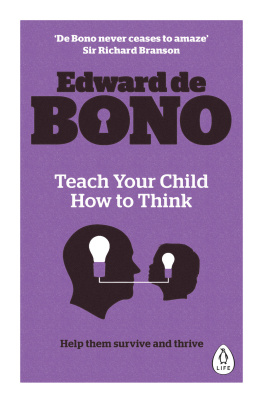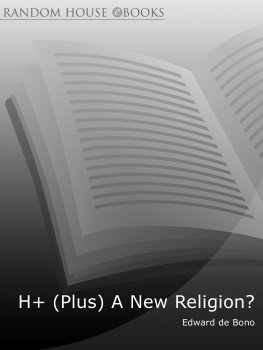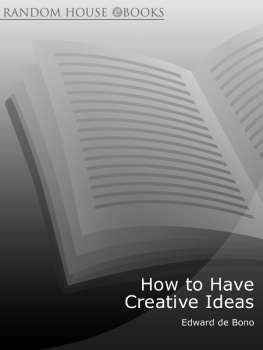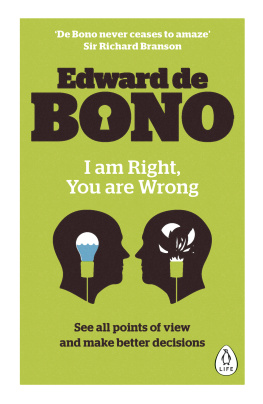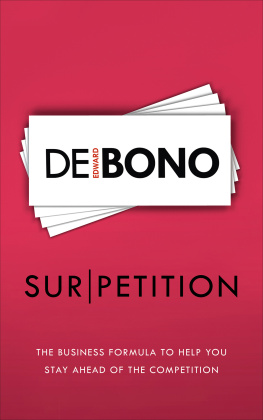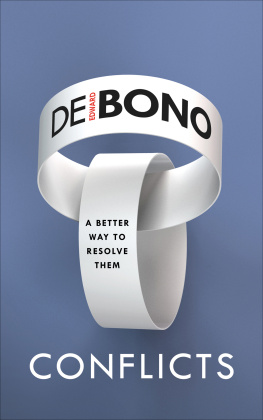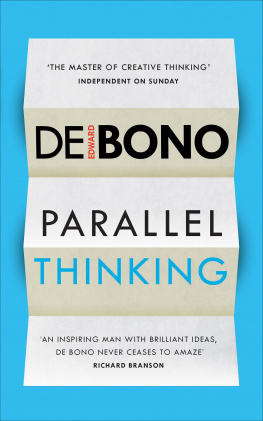De Bono - Lateral Thinking: a Textbook of Creativity
Here you can read online De Bono - Lateral Thinking: a Textbook of Creativity full text of the book (entire story) in english for free. Download pdf and epub, get meaning, cover and reviews about this ebook. City: London, year: 2009;1970, publisher: Penguin Group UK, genre: Religion. Description of the work, (preface) as well as reviews are available. Best literature library LitArk.com created for fans of good reading and offers a wide selection of genres:
Romance novel
Science fiction
Adventure
Detective
Science
History
Home and family
Prose
Art
Politics
Computer
Non-fiction
Religion
Business
Children
Humor
Choose a favorite category and find really read worthwhile books. Enjoy immersion in the world of imagination, feel the emotions of the characters or learn something new for yourself, make an fascinating discovery.
Lateral Thinking: a Textbook of Creativity: summary, description and annotation
We offer to read an annotation, description, summary or preface (depends on what the author of the book "Lateral Thinking: a Textbook of Creativity" wrote himself). If you haven't found the necessary information about the book — write in the comments, we will try to find it.
Lateral Thinking: a Textbook of Creativity — read online for free the complete book (whole text) full work
Below is the text of the book, divided by pages. System saving the place of the last page read, allows you to conveniently read the book "Lateral Thinking: a Textbook of Creativity" online for free, without having to search again every time where you left off. Put a bookmark, and you can go to the page where you finished reading at any time.
Font size:
Interval:
Bookmark:
PENGUIN BOOKS
LATERAL THINKING
Edward de Bono has had faculty appointments at the universities of Oxford, London, Cambridge and Harvard. He is widely regarded as the leading authority in the direct teaching of thinking as a skill. He originated the concept of lateral thinking and developed formal techniques for deliberate creative thinking. He has written sixty-two books, which have been translated into thirty-seven languages, has made two television series and there are over 4,000,000 references to his work on the Internet.
Dr de Bono has been invited to lecture in fifty-two countries and to address major international conferences. In 1989 he was asked to chair a special meeting of Nobel Prize laureates. His instruction in thinking has been sought by some of the leading business corporations in the world such as IBM, DuPont, Shell, Ericsson, McKinsey, Ciba-Geigy, Ford and many others. He has had a planet named after him by the International Astronomic Union and was named by a group of university professors in South Africa as one of the 250 people in all of history who have contributed most to humanity.
Dr de Bono runs the most widely used programme for the direct teaching of thinking in schools. This is now in use in many countries around the world.
Dr de Bonos key contribution has been his understanding of the brain as a self-organizing system. From this solid base he set out to design practical tools for thinking. His work is in use equally in the boardrooms of some of the worlds largest corporations and with four-year-olds in school. His design of the Six Hats method provides, for the first time, Western thinking with a constructive idiom instead of adversarial argument. His work is in use in lite gifted schools, rural schools in South Africa and Khmer villages in Cambodia. The appeal of Dr de Bonos work is its simplicity and practicality.
For more information about Dr de Bonos public seminars, private seminars, certified training programmes, thinking programmes for schools, CD Rom, books and tapes, please contact: Diane McQuaig, The McQuaig Group, 132 Rochester Avenue, Toronto M4N 1P1, Ontario, Canada. Tel: (416) 488 0008. Fax: (416) 488 4544. Internet: http://www. edwdebono.com
Titles published by Penguin:
Atlas of Management Thinking
Conflicts: A Better Way to Resolve Them
The de Bono Code Book
Edward de Bonos Masterthinkers Handbook
Edward de Bonos Textbook of Wisdom
The 5-Day Course in Thinking
Handbook for the Positive Revolution
The Happiness Purpose
How to be More Interesting
I Am Right You Are Wrong
Lateral Thinking
Lateral Thinking for Management
New Thinking for the New Millennium
Opportunities
Parallel Thinking
Po: Beyond Yes and No
Practical Thinking
Simplicity
Six Thinking Hats
Teach Your Child How to Think
Teach Yourself to Think
Teaching Thinking
The Use of Lateral Thinking
Water Logic
Wordpower
Edward de Bono
A Textbook of Creativity

Penguin Books
PENGUIN BOOKS
Published by the Penguin Group
Penguin Books Ltd, 80 Strand, London WC2R 0RL, England
Penguin Putnam Inc., 375 Hudson Street, New York, New York 10014, USA
Penguin Books Australia Ltd, 250 Camberwell Road, Camberwell, Victoria 3124, Australia
Penguin Books Canada Ltd, 10 Alcorn Avenue, Toronto, Ontario, Canada M4V 3B2
Penguin Books India (P) Ltd, 11 Community Centre, Panchsheel Park, New Delhi 110 017, India
Penguin Books (NZ) Ltd, Cnr Rosedale and Airborne Roads, Albany, Auckland, New Zealand
Penguin Books (South Africa) (Pty) Ltd, 24 Sturdee Avenue, Rosebank 2196, South Africa
Penguin Books Ltd, Registered Offices: 80 Strand, London WC2R 0RL, England
www.penguin.com
First published by Ward Lock Education 1970
Published in Pelican Books 1977
Reprinted in Penguin Books 1990
35
Copyright Edward de Bono, 1970
All rights reserved
Except in the United States of America, this book is sold subject to the condition that it shall not, by way of trade or otherwise, be lent, re-sold, hired out, or otherwise circulated without the publishers prior consent in any form of binding or cover other than that in which it is published and without a similar condition including this condition being imposed on the subsequent purchaser
ISBN: 978-0-14-193831-8
This book is intended for use both at home and at school At school the emphasis has traditionally always been on vertical thinking which is effective but incomplete. This selective type of thinking needs to be supplemented with the generative qualities of creative thinking. This is beginning to happen in some schools but even so creativity is usually treated as something desirable which is to be brought about by vague exhortation. There is no deliberate and practical procedure for bringing it about This book is about lateral thinking which is the process of using information to bring about creativity and insight restructuring. Lateral thinking can be learned, practised and used. It is possible to acquire skill in it just as it is possible to acquire skill in mathematics.
The book should be of use to teachers who are looking for a practical way to handle this type of thinking which is becoming ever more important The book provides formal opportunities to practise lateral thinking and also an explanation of the processes involved. The teacher may either use the book for his or her own interest or, better still, as a basis for classroom work.
Since the universal introduction of practical creativity into school education may take some time to come about, parents might not wish to wait for this. They might prefer to supplement the school situation with home instruction in lateral thinking.
It is emphasized that there is no antagonism between the two sorts of thinking. Both are necessary. Vertical thinking is immensely useful but one needs to enhance its usefulness by adding creativity and tempering its rigidity. Eventually this will be done at school but until that time it may be necessary to do it at home.
The book is not intended to be read through at one sitting but worked through slowly over months or even years. For that reason many of the principles are repeated at intervals throughout the book in order to hold the subject together and prevent it fragmenting into mere techniques. In using the book it is important to remember that practice is far more important than understanding of the process.
Lateral thinking is closely related to insight, creativity and humour. All four processes have the same basis. But whereas insight, creativity and humour can only be prayed for, lateral thinking is a more deliberate process. It is as definite a way of using the mind as logical thinking but a very different way.
Culture is concerned with establishing ideas. Education is concerned with communicating those established ideas. Both are concerned with improving ideas by bringing them up to date. The only available method for changing ideas is conflict which works in two ways. In the first way there is a head on confrontation between opposing ideas. One or other of the ideas achieves a practical dominance over the other idea which is suppressed but not changed. In the second way there is a conflict between new information and the old idea. As a result of this conflict the old idea is supposed to be changed. This is the method of science which is always seeking to generate new information to upset the old ideas and bring about new ones. It is more than the method of science it is the method of human knowledge.
Font size:
Interval:
Bookmark:
Similar books «Lateral Thinking: a Textbook of Creativity»
Look at similar books to Lateral Thinking: a Textbook of Creativity. We have selected literature similar in name and meaning in the hope of providing readers with more options to find new, interesting, not yet read works.
Discussion, reviews of the book Lateral Thinking: a Textbook of Creativity and just readers' own opinions. Leave your comments, write what you think about the work, its meaning or the main characters. Specify what exactly you liked and what you didn't like, and why you think so.

